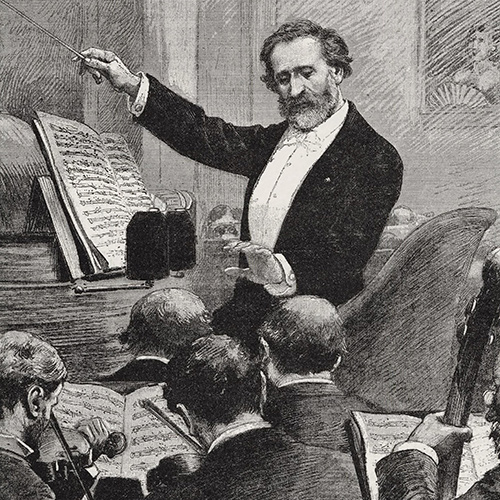
Illustration of Giuseppe Verdi
The operas La traviata and Rigoletto by Giuseppe Verdi occupy unassailable positions as two of the most frequently performed in the world today, and his Aida and Otello have also maintained widespread popularity since their first performances in the late 19th century. Recognized as pinnacles of inspiration from an operatic master widely regarded as the national composer of Italy, these works are treasured for their emotional power and exceptional understanding of the capabilities of the solo voice singing in Italian.
Musicologist Daniel E. Freeman offers a survey of four of Verdi’s most popular operas with an emphasis on the ways in which they reflect the composer’s approach to musical setting and character development. Analysis of the principal musical and dramatic components of each work includes video recordings of performances staged at the world’s leading opera houses.
Freeman teaches at the University of Minnesota and lectures nationally and internationally on classical music and opera.
October 19 Verdi’s Operatic Style
As a young composer in the 1840s and early 1850s, Verdi shaped the last phases of what is known as Italian bel canto opera, which put an emphasis on florid vocal passagework and a sectional approach to presenting dramatic action in opera. During the remainder of his operatic career, he gradually moved toward a more “natural” approach that de-emphasized elaborate vocal display and cultivated a more fluid way of staging dramatic incidents in the manner of spoken drama. His creative energies were focused above all on the production of memorable melodic profiles, and he generally avoided the harmonic complexities of contemporaries such as Richard Wagner. Verdi’s operas in general conform to a serious style cultivated in Italy between ca. 1830 and 1890 that emphasized settings in the distant past that ended with the death of one or both of the principal lovers.
October 26 Rigoletto (1851)
The title character of Rigoletto is a “hunchback” court jester in Renaissance Italy. Obsessed with a lifetime of anger and bitter resentments, his only sincere object of affection is his daughter Gilda, whom he accidentally murders as part of a plot to punish his employer, the Duke of Mantua, for trifling with his daughter romantically.
November 2 La traviata (1853)
Based on a contemporary novel about the life of a Parisian courtesan, La traviata explores a love affair between Violetta and Alfredo, a scion of a wealthy family. After Violetta breaks off their relationship to preserve the reputation of his family, she dies of tuberculosis with Alfredo at her deathbed.
November 9 Aida (1871)
Verdi’s Aida is a magnificent operatic spectacle originally commissioned to celebrate the opening of the Suez Canal in 1869. Set in ancient Egypt, the story centers on the love of Radames, an Egyptian captain of the guard, for a captive Ethiopian princess named Aida. Amneris, daughter of the king of Egypt, is consumed with jealousy of Aida. Her plans to win Radames for herself fail when he is sentenced to death for treason and buried alive with Aida.
November 16 Otello (1887)
Based on Shakespeare’s play Othello, Verdi’s operatic adaption is a harrowing tale of a mythical governor of Cyprus in the late Middle Ages who murders his wife on the basis of a false accusation of adultery perpetuated by his retainer Iago. Both in the opera and the play, Otello is identified as a “Moor,” a vague term whose racial implications have been the source of many controversies in casting and staging.
5 sessions
General Information